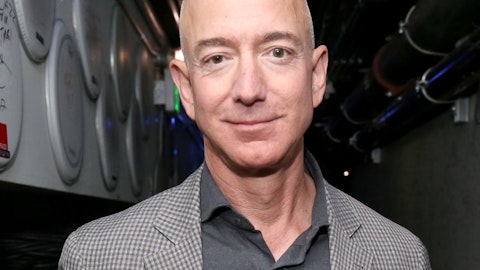Josh James: Yeah. So, the problem before, when we were starting to get excited about the ecosystem and we were building relationships with some folks, especially the big data providers, we’d walk into accounts with reps, and then their customer that they introduced us to might start pulling some compute out of our partner and putting it into Domo. And of course, that’s the end of those relationships, right? You’re taking dollars out of the pockets of the reps of the partners. And so that was DOA as soon as that started. And so, what we’ve done now is we said, okay, we can take that compute component, where the data lives and how it gets queried and processed, and we can run that inside Snowflake or inside AWS or inside Microsoft.
So, any partner that brings us in, we can keep all the computing charges and credits that are being used up actually with the partner. And so that changes the dynamic pretty meaningfully because now we have complete alignment except for instead of 40 users that you may have at — even a big Fortune 500 company, from 40 users or 100 users to 5,000, 10,000, when you add the Domo front-end on top of that. And that’s 5,000 and 10,000 people that are now querying and running reports that are all driving compute on the back-end of a Snowflake or a Databricks or a Microsoft or an AWS or Google. So, we feel like we’re in a much, much better position. And that coupled with premium, there’s been plenty of conversations where we’re talking to a partner and someone that maybe we have 300 customers that have connected to their data.
So, we know it’s popular inside our network and we know that we provide a lot of visibility into the data that’s inside that partner’s analytics and the partner will come to us and say, “Gosh, it’d be great if we could give this to the other 10,000 customers that we have.” And then we say, “Yeah, great. You should do that. It’s, let’s see, $840,000.” And the partners like, “What? Well, we don’t know the values yet.” We’re like, “Yeah. But we will give you upside if they converted to the Domo customers.” They’re like, “Yeah, that seems like a good idea on paper, but I don’t know if we can lean in and make the commitment, make the investment without seeing a return. So, maybe we should just try it out with a couple of customers.” And by then, you’ve lost momentum.
Whereas now, we can go in that same customer, that same conversation, we say, “Yes, we can get it to all 10,000. Let’s do it on freemium. Let’s build some quick start guides so that the second you roll this out, the customer is able to log into Domo, see all of the data from you as a partner. We’ll build out the dashboards. We’ll build out the alerts.” They’re going to get this great white-glove, perfect experience replicated 10,000 times automatically. And in there, they can see, “Hey, this is your Domo experience for this data from your partner. If you want it for everything else, here’s your freemium account, just keep going.” And then, we tell the partner, “Any upside, we’re going to give you guys a piece of it.” So all of a sudden, providing data to their customers becomes not a cost center, it becomes a profit center.
And we’ve seen a bunch of traction in just even the last month for that. So, we’re really excited about our ability to provide Domo Everywhere through our freemium offering.
Pat Walravens: Great. And then, Dave, on the debt?
David Jolley: Yeah. So, our current debt, as you might recall, we raised that debt even prior to our IPO when we were still using a lot — consuming a lot of cash. And so, it’s very expensive debt. It carries a cash interest component and a PIK interest component, some other payments that push the effective interest rate north of 14% is where we’re at today. And it’s got a maturity of April ’25. And so, we’ve gone out with a refinancing and got a bank helping us, and we’re looking at cash interest component of a little over 11% right now based on where SOFR is at. We’re hearing some good things about where rates might go next year, but it’ll bring our rate down substantially and push our maturity date out to ’29 or ’30. So, it sort of puts it out well out into the future and it eliminates some of the other PIK interest and some of the other elements.
Pat Walravens: All right, terrific. Thanks to both of you.
Operator: One moment everyone, the speaker line has disconnected. One moment we reestablish the audio. Once again, everyone, please stand by. We’ll establish that audio line momentarily. Please stay on the line. Once again everyone, you are on hold for the Domo, Inc. conference call. We are establishing the speaker line. Please stand by. You are now live.
Josh James: All right. Sounds like Pat said thanks, we heard, and there was another question. Is the question still on?
Operator: Yes. One moment. We’ll take our next question from Derrick Wood with T.D. Cowen.
Unidentified Analyst: Hey, guys. Thanks. This is Cole on for Derek. On the RIF that you talked about, we’d just like to get a little bit more color. Is that across sales, G&A? If you can just unpack that a bit, that’d be helpful.
Josh James: Yeah, we — it was across every department. There was — the majority of it was in sales. We’re in terms of growth, not where we want to be. And so for the most part, it was based on performance. Some of it was just positions that were eliminated, as we found a more optimized way of accomplishing certain things. It wasn’t a huge number, but it was still several dozen humans that were affected. So, a little bit of a rough day here at the office, but at the same time, I feel like the company is in a better position. And it’s not a dramatic effect on our ability to produce. We think in many cases, actually, taking a smaller number of leads distributed — I mean, taking the same number of leads distributed to a smaller number of reps will actually be an improvement for the reps that are here to make sure that they’re being fed.
So, overall, I don’t think it’s going to be too impactful to our company. It just, obviously, impacts the folks that were affected by it.
Unidentified Analyst: Sounds good. Helpful. Just building on that too, for the reps that you still have at Domo, how is productivity trending? Any new initiatives around helping them sell consumption better would be helpful to hear about things.
Josh James: Yeah, we have all kinds of initiatives around helping them to consumption. We had a Board meeting just recently and walked through our consumption deck and showed the Board members all the positive things that are happening and all the negative things that we might be able to find as well. And the resounding answer was — from the Board was, “Move as fast as you possibly can. We don’t see anything that would cause us concern about you moving as fast as you possibly can.” So, to that end, doing as many things as we can to drive the transition to consumption, things like we’ve built out a brand new adoption group that’s focused on going into our — especially our bigger customers, and helping them, it’s a great phone call.
We call a customer, and we’re not asking for a new contract. We’re not asking to go get approval from procurement. We’re just walking in saying, “Hey, we’d love to come in and show you best uses for data science,” or “We’d love to come in and talk to you about identifying opportunities inside your marketing spend.” And they love those conversations. All we’re doing is walking in and helping them, but we’re helping them identify additional use cases, which, of course, ends up driving consumption. So those are the types of things that we’re doing with the customer. And then, we’re re-evaluating the different departments that we have and what each group does. So, reps, their job on renewal. What’s what is the job on renewal? Is the job to go and procure another contract, or is the job to help identify some more use cases?




